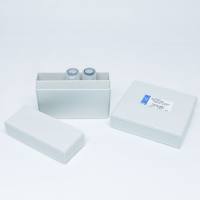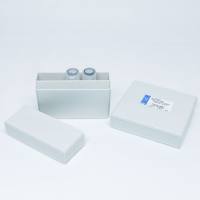Run-On Transcription
互联网
Run-on transcription monitors the regulation of transcription in isolated nuclei.
A. Preparation of Nuclei - (do everything at 0℃ to 4℃ in 50 ml tubes)
1. Pellet between 30 and 300 million cells at 1,500 X g for 10 min.
2. Remove the supernatant and resuspend the cells in 20 to 50 ml PBS and repellet the cells at 1,500 X g for 10 min.
3. Remove the supernatant and resuspend the cells in 2 ml RSB and allow cells to swell for 5 min on ice.
4. Add 2 ml RSB/NP-40 and leave on ice for 5 min and check for cell lysis under a microscope.
5. Pellet the nuclei at 2,000 X g for 10 min at 4℃
B. Run-On Transcription Reaction
1. Resuspend the nuclei in 150 2X Transcription Mix and 30 μl 10X Nucleotide Mix, 500 μCi [32P ]-rUTP, and bring the final reaction volume to 300 μl with ddH2 O (take the volume of the nuclei into account).
2. Incubate at 37℃ for 10 min.
3. Lyse the nuclei by adding 1.5 ml of 6M Guanidium Chloride and shear the DNA by passing the sample through a 19 gauge needle on a syringe.
4. Extract the lysate by adding an equal volume of SEVAG and vortexing vigorously. Centrifuge for 30 min at 35,000 rpm at 20℃ in a J6M rotor and recover the aqueous phase.
5. Add 2.5 volumes of Ethanol and pellet the nucleic acids by centrifuging at 35,000 rpm at 4℃ for 20 min in a J6M rotor.
6. Remove the supernatant and resuspend the pellet in 200 to 500 μl DNase solution and incubate at 37℃ for 15 min.
7. Extract the reaction solution by adding an equal volume of SEVAG and vortexing vigorously. Centrifuge for 30 min at 35,000 rpm at 20℃ in a J6M rotor and recover the aqueous phase.
8. Add 2.5 volumes of Ethanol and pellet the nucleic acids by centrifuging at 35,000 rpm at 4℃ for 20 min in a J6M rotor.
9. Dissolve the pellet in 100 μl 10 mM Tris. Run the solution through a G50 column to separate run-off transcripts from unincorporated nucleotide.
10. Add 2.5 volumes of Ethanol to the purified transcripts and pellet the nucleic acids by centrifuging at 35,000 rpm at 4℃ for 20 min in a J6M rotor. Dissolve the transcripts in 250 μl 20 mM HEPES, pH 7.5.
C. Alkaline Hydrolysis of Run-Off Transcripts
1. Add 63 μl of 1 M NaOH to the transcripts and leave on ice for 15 min.
2. Add 125 μl 1M HEPES free acid, 50 μl 3M sodium acetate, and 1 ml Ethanol to precipitate the nucleic acids. Pellet the nucleic acids by centrifuging at 35,000 rpm at 4℃ for 20 min in a J6M rotor.
3. Dissolve the pellet in 50 μl ddH2 O
4. Check the size of the transcripts by electrophoresis of an aliquot of the nucleic acids on a 7 M Urea, 5% acrylamide gel. The transcripts should be 200 to 500 nucleotides long. (See protocol on Polyacrylamide Gel Electrophoresis).
D. Preparation of Filters
1. Cut the size of a Gene Screen Plus filter to the size of a Schleicher and Schuell slot blot manifold.
2. Soak the filter in 0.4 M Tris, pH 7.0 for 30 min. Place the filter into the slot blot manifold.
3. To load 5 μg of dsDNA, ssM13 DNA, or RNA probe in each slot, take up the DNA or RNA in 40 μl 10 mM Tris, pH 7.0 and add 4 μl 3 M NaOH and incubate for 10 min at room temperature. Add 1 volume 2 M Ammonium Acetate, pH 7.0 and load DNA or RNA onto the slot blotter and apply the vacuum to draw the solution through the slot. Rinse each slot with a few drops of 1 M Ammonium Acetate.
4. Fix the DNA or RNA onto the filter by exposing it to short wave UV light for one min. Alternatively, use a Stratalinker on the auto crosslink setting.
E. Hybridization
1. Soak the filter in hybridization mix for at least 2 hours.
2. Add 100 μg/ml Salmon Sperm competitor DNA to the transcripts and denature the samples at 100℃ for 2 min before adding to the hybridization mix. Remove the prehybridization buffer from the filter. Add the transcript volume to 2 ml of hybridization buffer and incubate with the filter for 2 days at 42℃.
3. After the hybridization, soak the hybridized filter at 65℃ in wash buffer for the appropriate amount of time (see Hint #2).
6 M Guanidium Chloride
| Wash Buffer | 1% (w/v) SDS 2X SSC |
|
| Hybridization Mix | 1% (w/v) SDS 25 mM Sodium Phosphate, pH 7.0 5X SSC 0.1% (w/v) Sodium Pyrophophate 50% (v/v) Formamide (CAUTION! see Hint #1) 5X Denhardt's |
|
| SSC (20X) | pH 7.2 3 M NaCl 0.3M Sodium Citrate |
|
| Denhardt Solution (100X) | 10 g Ficoll 400 10 g Polyvinylpyrrolidone 10 g Bovine Serum Albumin (fraction V) Bring final volume to 500 ml with ddH2 O Store at -20°C in aliquots |
|
| 1 M Ammonium Acetate, pH 7.0 | ||
| RSB | 10 mM NaCl 5 mM MgCl2 10 mM Tris, pH 7.5 |
|
| PBS | pH 7.2 1.8 mM KH2 PO4 4.3 mM Na2 HPO4 2.7 mM KCl 137 mM NaCl |
10 mM Tris
0.4 M Tris, pH 7.0
1 M HEPES free acid
1 M NaOH
20 mM HEPES, pH 7.5
| DNase Solution | 50 mM NaCl 10 mM MgCl2 Plus RNase-free DNase I 10 mM Tris, pH 7.5 |
|
| SEVAG | 25:24:1 Phenol:Chloroform:Isoamyl Alcohol (CAUTION! see Hint #1) |
|
| Nucleotide Mix (10X) | 10 mM dATP 10 mM dCTP 10 mM dGTP |
|
| Transcription Mix (2X) | 180 mM KCl 50 mM DTT 20 mM Tris, pH 10 mM MgCl2 |
Tris
Sodium Pyrophosphate
DNase I, Rnase-free
HEPES, Free Acid
Guanidium Chloride
Ficoll 400
Oligonucleotide
ATP
Sodium Phosphate
Magnesium Chloride
Isoamyl Alcohol
Sodium Citrate
GTP
Chloroform
CTP
Sodium Phosphate, Dibasic
Phenol
Potassium Chloride
Sodium Chloride
Bovine Serum Albumin (BSA), Fraction V
Polyvinyl Pyrolidone
SDS
HEPES
Formamide
Ammonium Acetate
DTT
Potassium Phosphate, Monobasic
1. CAUTION! This substance is a biohazard. Consult this agent's MSDS for proper handling instructions.
2. The wash time needs to be empirically determined and depends on the nature of the probe used and the extent of background signal minimization desired.






